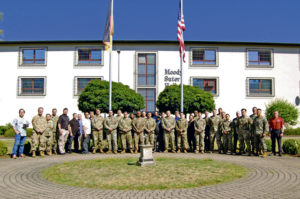One hears the rationale behind the creation of Army Air Defense Artillery Fire Control Officers was to place the human factor back into how Army ADAFCO personnel bridge the gap in integrated air and missile defense. That human factor can be best described as the lifeblood of the Army’s Air Defense Artillery. ADAFCO teams must exist in order to integrate Army Air Missile Defense engagement operations into the Joint Integrated Air Defense System.
The 678th Air Defense Artillery Brigade has created the foundation to not only meet the standards of a National Guard ADA BDE, but to exceed those expectations. The brigade participated in the Spartan Shield 20-7, exercise where their ADAFCO’s attended the Army’s ADAFCO Table VIII certification course from July 20-23 at the Warrior Preparation Center on Einsiedlerhof Air Station.

“This training is important because in a real-world situation the service members here can employ Patriot missile battalions and defend our maneuvering units and our partners and allies,“ said Army Capt. Brendon Gregory, an Air Defense Officer, assigned to the 10th Army Air and Missile Defense Command, said. “This exercise also helps with deconflicting of fires with a joint and combined kill chain.”
For the first time ever, the 678th ADA Brigade completed the Table VIII Air Defense Artillery Fire Control Officer Certification in the European Theater, Gregory said.
Beginning on July 15, the training started with a classroom portion to orient or refresh the trainees on tactics, techniques and procedures for operating in a joint kill chain, Gregory explained. The class primarily revolved around the use of Patriot missile air defense assets interlaced with Air Force aircraft for defensive counter strikes.
During the ADAFCO Table VIII training Soldiers were exposed to training environments that challenged and developed individuals, crews, and battery personnel to intermediate levels of proficiency in Patriot weapon systems. This is by no means an easy feat, as Soldiers assigned to Patriot units at the brigade level and below must be able to successfully pass evaluations through a series of collective events that provide a means for instilling crew integrity, teamwork, and unit cohesiveness. The 678th ADA BDE has two NCOs who were trained to complement their ADAFCO counterparts and are known as Air Defense Artillery Fire Control Assistants.
With the Theater Air Control System, the Soldiers, Airmen and Marines served as the primary integration and deconfliction point for fighters conducting defensive counter-air, offensive counter-air, suppression of enemy air defense, and air defense artillery fire control during the exercise, said Gregory. Deconfliction between the control reporting centers and the air defense assets has improved immensely.
“Being able to transition from a background in Short Range Air Defense to the Patriot missile system allowed me to understand how the air picture can change between the two systems,” said U.S. Army Staff Sgt. Matthew Hecko, an air defense artillery fire control assistant, assigned to the 678th ADA Brigade, 10th Army Air and Missile Defense Command.
Air Defense Artillery Fire Control Officer teams were created during Operation Iraqi Freedom in 2003 because of friendly fire that occurred in combat. The ADAFCO Table VIII certification validates the participating units’ ability to operate in combat and mitigate potential fratricides.
“This training is unique because we have a much better opportunity to integrate with our Army Air Defense counterparts,” said Air Force Capt. Quincy Whitham, assigned to the 606th Air Control Squadron. “Training together, and knowing how to operate with the different services and realizing that integration is absolutely critical for the defense of Europe and our allies.”


